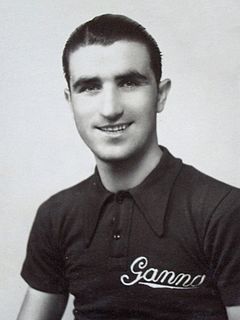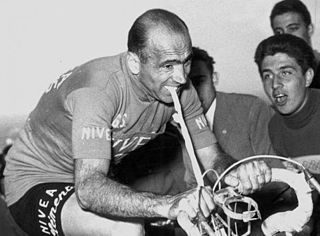
The Giro d'Italia is an annual multiple-stage bicycle race primarily held in Italy, while also occasionally passing through nearby countries. The first race was organized in 1909 to increase sales of the newspaper La Gazzetta dello Sport; however it is currently run by RCS Sport. The race has been held annually since its first edition in 1909, except when it was stopped for the two world wars. As the Giro gained prominence and popularity the race was lengthened, and the peloton expanded from primarily Italian participation to riders from all over the world. The Giro is a UCI World Tour event, which means that the teams that compete in the race are mostly UCI ProTeams, with the exception of the teams that the organizers can invite.
The 1957 Giro d'Italia was the 40th running of the Giro d'Italia, one of cycling's Grand Tour races. The Giro started in Milan, on 18 May, with a 191 km (118.7 mi) stage and concluded in Milan, on 9 June, with a 257 km (159.7 mi) leg. A total of 120 riders from 15 teams entered the 21-stage race, which was won by Italian Gastone Nencini of the Leo-Chlorodont team. The second and third places were taken by Frenchman Louison Bobet and Italian Ercole Baldini, respectively.

Carrera was an Italian-based road bicycle racing team active from 1984 to 1996, named after sponsoring Italian jeans manufacturer Carrera. The team was successful in the Giro d'Italia and the Tour de France with three overall wins and several wins in the Points classification and Mountain Classifications.

Bianchi was an Italian professional cycling team that was sponsored by and cycled on Bianchi Bicycles. A Bianchi cycling team existed in 1899 which implies that Bianchi was sponsoring professional cycling at a very early stage in the sport. It appears that the team existed from 1899 to 1900, then from 1905 to 1966, then from 1973 until 1984. It existed again in 1993 and for the last time in 2003, as Team Bianchi. In addition Bianchi has been a co-sponsor of many cycling teams.
The 1946 Giro d'Italia was the 29th edition of the Giro d'Italia, a cycling race organized and sponsored by the newspaper La Gazzetta dello Sport. The race began on 15 June in Milan with a stage that stretched 185 km (115 mi) to Turin, finishing back in Milan on 7 July after a 176 km (109 mi) stage and a total distance covered of 3,039.5 km (1,889 mi). The race was won by the Italian rider Gino Bartali of the Legnano team, with fellow Italians Fausto Coppi and Vito Ortelli coming in second and third respectively.
The 1937 Giro d'Italia was the 25th edition of the Giro d'Italia, a cycling race organized and sponsored by the newspaper La Gazzetta dello Sport. The race began on 8 May in Milan with a stage that stretched 165 km (103 mi) to Turin, finishing back in Milan on 30 May after a split stage and a total distance covered of 3,840 km (2,386 mi). The race was won by the Italian rider Gino Bartali of the Legnano team, with fellow Italians Giovanni Valetti and Enrico Mollo coming in second and third respectively.

The 1913 Giro d'Italia was the 5th edition of the Giro d'Italia, a cycling race organized and sponsored by the newspaper La Gazzetta dello Sport. The race began on 6 May in Milan with a stage that stretched 341 km (212 mi) to Genoa, finishing back in Milan on 22 May after a 321.1 km (200 mi) stage and a total distance covered of 2,932 km (1,822 mi). The race was won by the Italian rider Carlo Oriani of the Maino team. Second and third respectively were the Italian riders Eberardo Pavesi and Giuseppe Azzini.

The 2017 Giro d'Italia was the 100th edition of the Giro d'Italia, one of cycling's Grand Tour races. The race started on 5 May in Alghero on the island of Sardinia, and ended on 28 May in Milan. The race was won by Tom Dumoulin, who became the first Dutch male winner of the Giro.

Salvarani was an Italian professional cycling team that existed from 1963 to 1972. The team was sponsored by the Italian kitchen components maker Salvarani.

Ferretti was an Italian professional cycling team that existed from 1969 to 1972. It was sponsored by the Ferretti kitchen company, based in Capannoli. Gösta Pettersson won the general classification of the 1971 Giro d'Italia with the team.

Maino was an Italian professional cycling team that existed from 1912 to 1936. Riders of the team won four editions of the Giro d'Italia. It was sponsored by Italian bicycle and motorcycle manufacturer Maino.

Frejus was an Italian professional cycling team that existed from 1935 to 1956. Its main sponsor was the Italian bicycle manufacturer Frejus. Whilst with Frejus, Giovanni Valetti won the general classification of the Giro d'Italia in 1938 and 1939.

Ganna was an Italian professional cycling team that existed in part between 1913 and 1953. It was started by Luigi Ganna, winner of the general classification of the inaugural Giro d'Italia, and was sponsored by his bicycle and motorcycle manufacturing company. Whilst with the team, Fiorenzo Magni won the general classification of the 1951 Giro d'Italia. The team was the predecessor of the Nivea–Fuchs team.

Nivea–Fuchs was an Italian professional cycling team that existed from 1954 to 1956. The team was formed when the Ganna team told its leader, Fiorenzo Magni, that it would not be able to continue and he gained the backing of the German cosmetics company Nivea to be the main sponsor of a new team. It was the first non-bicycle industry company team sponsor. Magni won the general classification of the 1955 Giro d'Italia with the team.
Wilier Triestina was an Italian professional cycling team that existed from 1946 to 1951. It was sponsored by Italian bicycle manufacturer Wilier Triestina. Fiorenzo Magni won the general classification of the 1948 Giro d'Italia with the team.

Stucchi was an Italian professional cycling team that existed in part between 1909 and 1951. Its main sponsor was Italian company Stucchi & Co. The team had two riders that won the general classification of the Giro d'Italia, Alfonso Calzolari in 1914 and Costante Girardengo in 1919.
Wolsit was an Italian professional cycling team that existed in part between 1910 and 1938. Its main sponsor was Italian bicycle manufacturer Wolsit. The team had two riders that won the general classification of the Giro d'Italia, Alfredo Binda in 1928 and Antonio Pesenti in 1932.
Gloria was an Italian professional cycling team that existed in part between 1927 and 1943. Its main sponsor was Italian bicycle manufacturer Gloria. Francesco Camusso won the general classification of the 1931 Giro d'Italia with the team.

Fides was an Italian professional cycling team that existed in 1961. Arnaldo Pambianco won the general classification of the 1961 Giro d'Italia with the team.
















